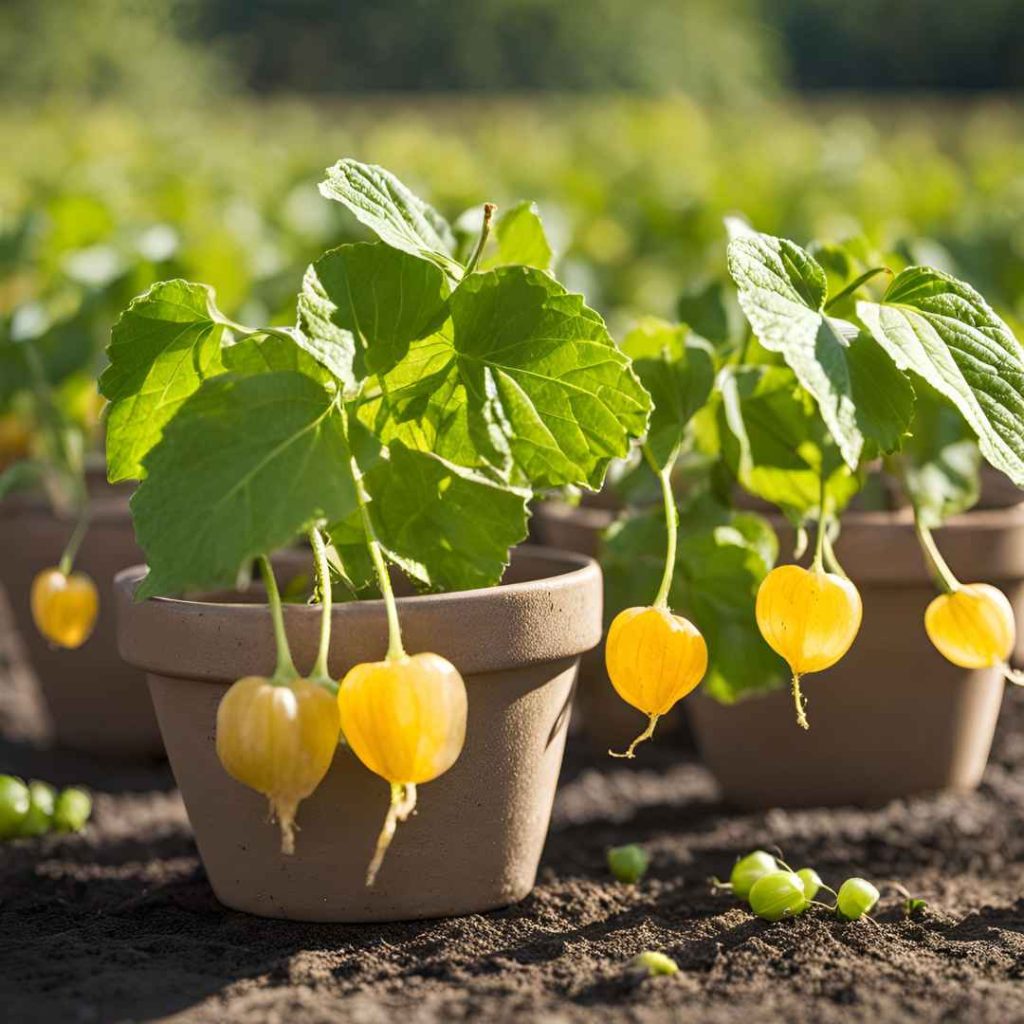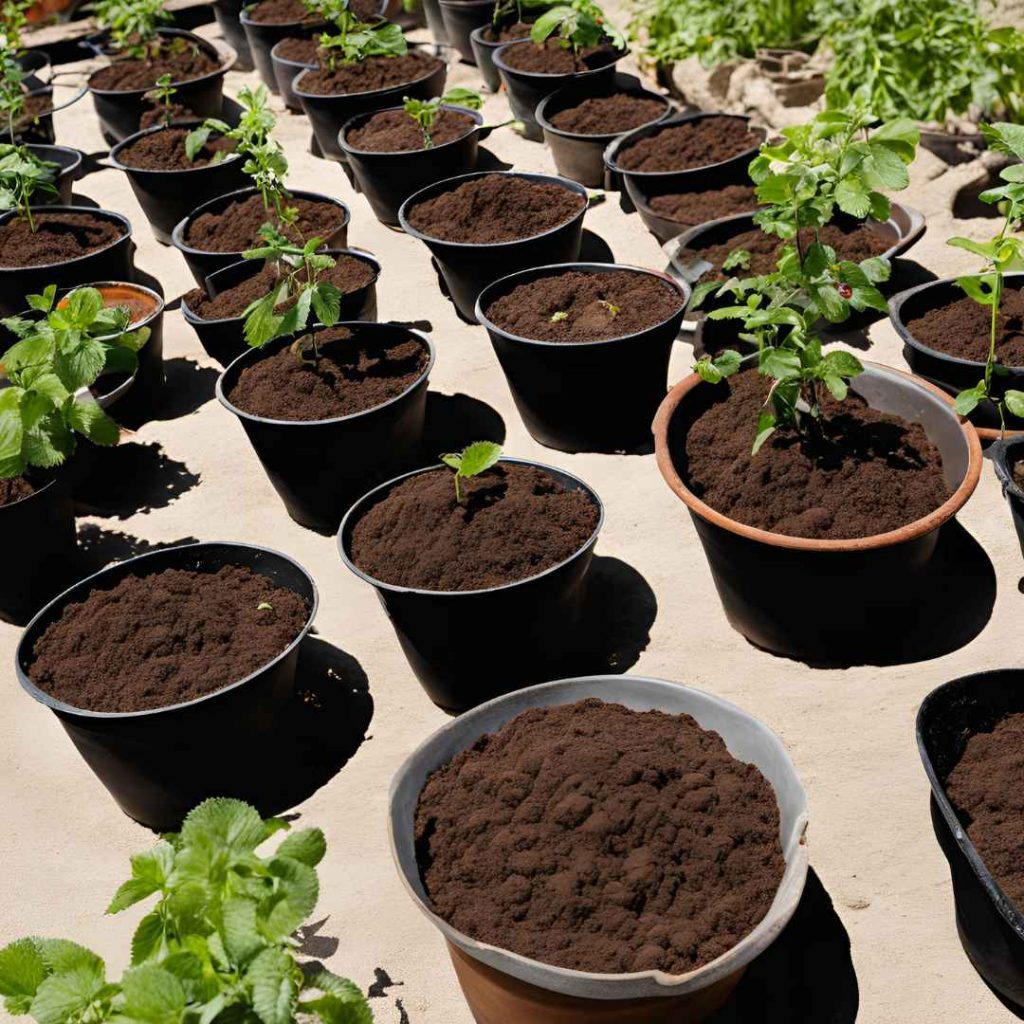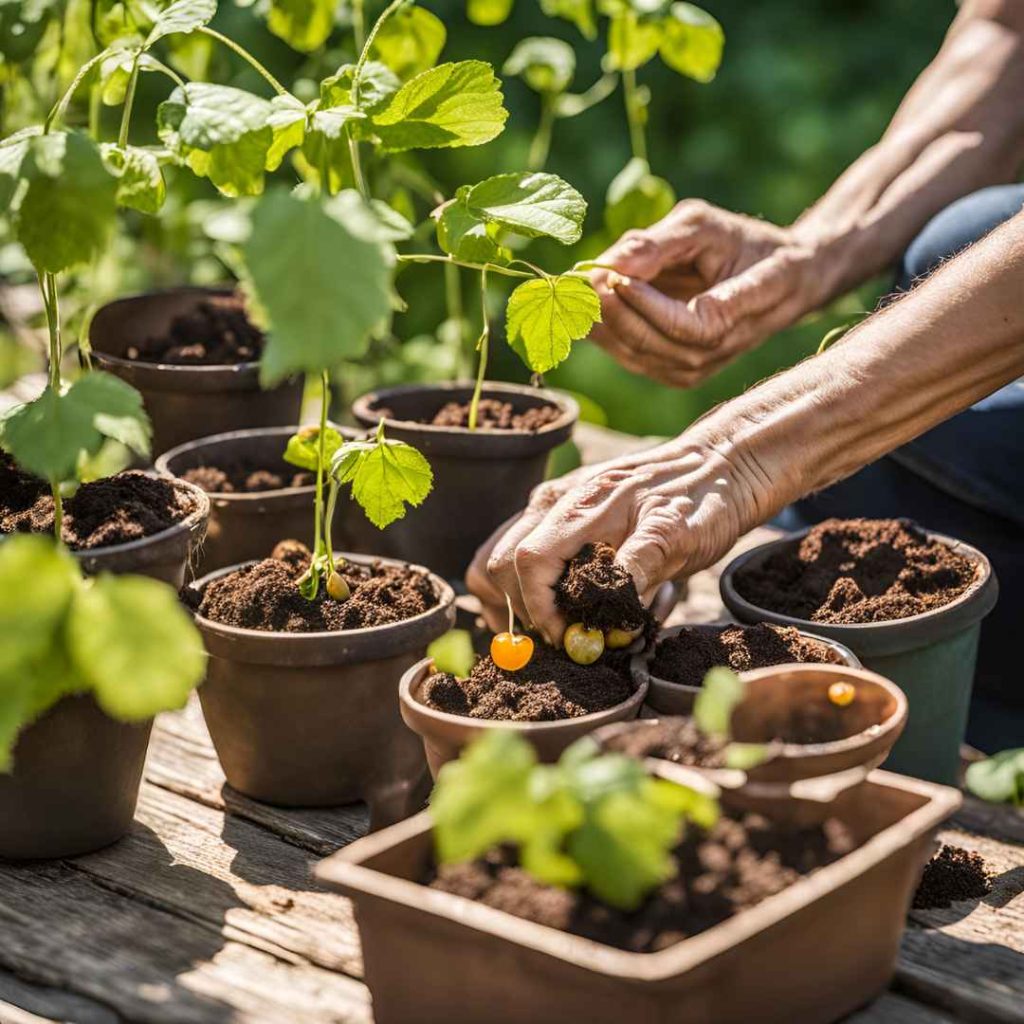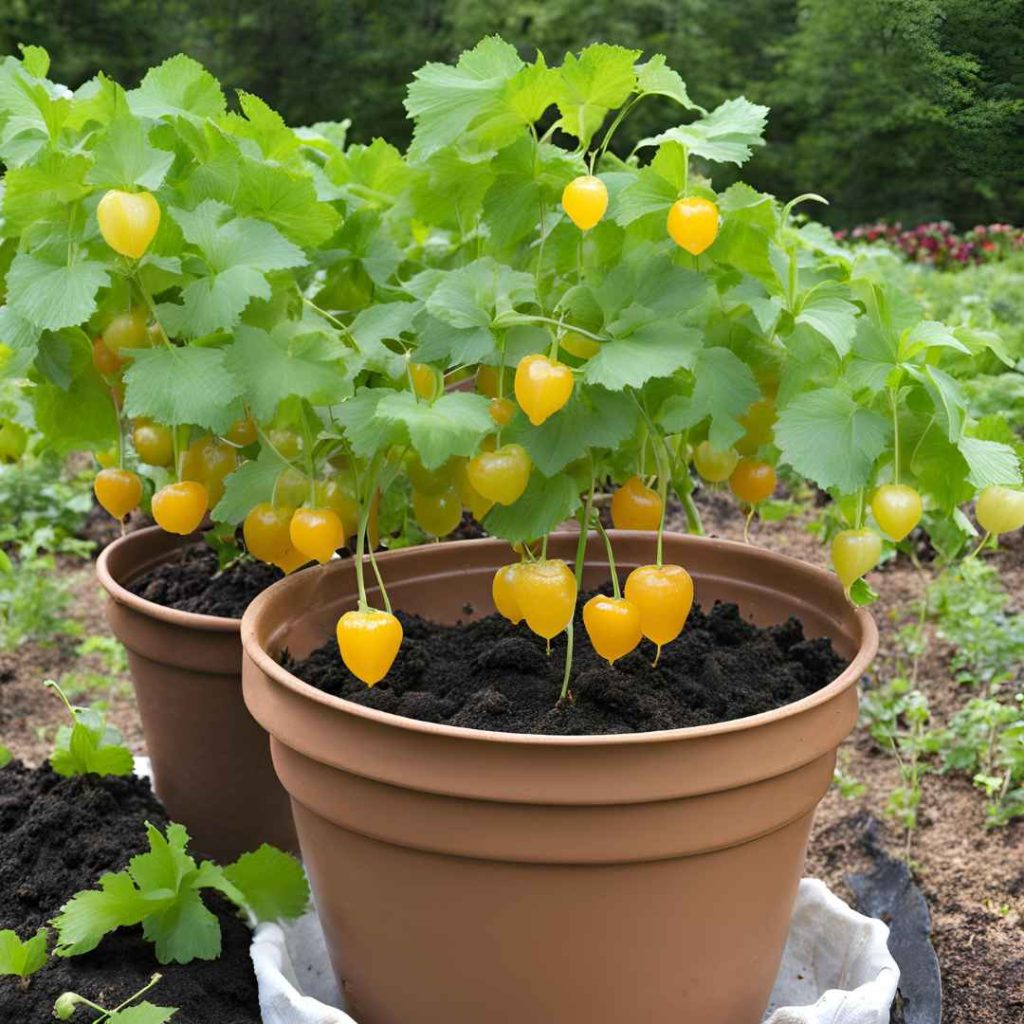Ground cherries are small, round fruits that grow in husks that look like lanterns and are made of paper. When they’re ready, they turn a golden yellow or orange color.
The plants are low and bushy, and their leaves are wide and serrated. They are in the same family as tomatillos (Salicaceae) and have broad, serrated leaves and small, bell-shaped yellow flowers. They grow to be about 1 to 3 feet tall.
Benefits Of Growing Ground Cherries
Nutritional Value
Ground cherries have a lot of good things for you in them, like iron, magnesium, fiber, vitamin A, vitamin C, vitamin B3, and vitamin B6.
These nutrients are very important for the health of your eyes, skin, muscles, nerves, brain development, energy production, blood flow, oxygen transport, and digestion.
Culinary Uses
The sweet and sour taste of ground cherries makes them useful in many cooking situations. As a fresh snack, they’re great, but you can also cook them down to make jam, put them in desserts like pies, tarts, and cakes, or use them to make sauces for meats or fish.
For extra sweetness and nutrition, you can also blend them into smoothies.
Garden Benefits
Through their small, yellow flowers, ground cherries bring good bugs like bees and other bugs to your garden. This makes more pollinators work, which makes the ecosystem more productive and alive.
Growing ground cherries not only gives you tasty fruit, but it also makes your garden healthier and more diverse.
Choosing The Right Variety

People love “Aunt Molly’s” ground cherries because they taste sweet, like pineapple, with hints of vanilla. People like them because they produce a steady crop and ripen early.
You can eat them fresh or make jams, pies, desserts, and preserves with them. In full sun, well-drained, fertile soil is best for them. The plant is called “pineapple” because its fruits taste like sweet pineapple. It works best in desserts, jams, and jellies.
It does best in full sun and soil that doesn’t stay soggy. You can grow it in pots. The “Cossack Pineapple” is known for having bigger fruits that taste like pineapple. It can be eaten fresh, baked, or used to make jams and jellies.
If you want your ground cherries to have a long growing season, you should plant them after the last frost date in your area.
They usually grow in USDA zones 4–8, but if you live somewhere cooler, you can make sure you get a good harvest by starting the seeds indoors and moving them outside after the risk of frost has passed. Pick the right type based on your climate, how you want to grow it, and how you plan to use the fruit.
Preparing For Planting
Sunlight Requirements

For growth, flowering, and fruit production, ground cherries need at least 6 to 8 hours of direct sunlight every day. They do best in places that face south and get full sun all day. They can grow fruit in some shade, but not as much as they would like to.
To get the most sun, pick a spot that isn’t blocked by buildings, trees, or other structures. When you prune nearby plants, more sunlight can reach ground cherry plants. If you are growing plants in pots, put them somewhere sunny and move them around as needed.
Giving ground cherries enough sunlight will improve their health as a whole, which will lead to stronger growth and more fruit.
Soil Preparation

The soil around ground cherries does best when the pH level is between 6.0 and 6.8. This is important for plant health and making sure nutrients are available. Use a soil test kit or send a sample to your local extension service to make sure the pH level is right.
You can change the pH by adding lime (calcium carbonate) to make the soil more alkaline (pH below 6.0) or sulfur, aluminum sulfate, or organic materials like peat moss or pine needles to make the soil more acidic (pH above 6.8).
Adding compost and other organic matter will also help the soil’s structure, fertility, and ability to hold water.
Apply a layer of 2 to 3 inches of high-quality compost or manure that is full of nutrients and good microorganisms over the planting area. Then, use a garden fork or tiller to work the compost into the top 6 to 8 inches of soil.
Planting Ground Cherries

Starting ground cherries indoors six to eight weeks before the last frost date in your area will give the seedlings time to get strong before moving them outside.
Some tips for germination are to use fresh seeds from a reputable source, seed-starting mix or potting mix that is light and drains well, and to water the soil slowly.
To keep plants from growing too tall, it’s important to keep the temperature between 70°F and 75°F (21°C and 24°C) and give them lots of light. When the seedlings get their first true leaves, separating them into one plant per cell or pot. This eliminates competition and makes the plants grow faster.
Before seedlings are transplanted, they have to go through a process called “hardening off,” which takes 1-2 weeks.
It is best to gradually expose the seedlings to sunlight and outdoor conditions over the course of seven to ten days. To protect them, bring them inside at night or when the temperature drops below 50°F.
Place plants 18 to 24 inches apart, and plant them at the same depth as they were in their pots. To plant a seedling, you need to dig a hole just a bit bigger than the root ball, put the seedling in the hole, cover it with soil, and water it well.
Growing Conditions
For best growth, ground cherries need consistent moisture. Depending on the weather, they should be watered once or twice a week. Mulch keeps soil moist by stopping water from evaporating, so roots always have access to water.
It also keeps the soil at the right temperature, stops weeds from growing, and makes the soil healthier by breaking down organic mulch. Some ways to get rid of weeds are to mulch, pull them out by hand, hoe, and plant cover crops during the off-season.
It is important to fertilize ground cherries with balanced, slow-release fertilizers that have an N-P-K ratio. Compost, well-rotted manure, or fish emulsion are all great organic options that will add nutrients to the soil and make it healthier over time.
The schedule includes fertilizing before planting, feeding regularly, and adding extra nutrients in the middle of the season. Through the right methods of watering, mulching, and fertilizing, ground cherries can create the best growing conditions that support healthy growth and a lot of fruit.
Care And Maintenance

There are several ways to grow ground cherries, which are a popular type of fruit. Their early growth can be used to shape the plants and get rid of stems that are weak or crowded. Pruning plants often during the growing season can help control their size and make the air flow better.
Get rid of any dead or damaged stems and suckers to keep the plant healthy and to send energy to the main stems. Putting stakes through ground cherries can help them stay upright and keep the fruit from touching the ground.
Ground cherries can also be grown in tomato cages. You can use trellising for bigger plants or in small gardens to save room and get more air moving.
Aphids, flea beetles, tomato hornworms, and whiteflies are some of the most common pests that attack ground cherries. Use neem oil, ladybugs, insecticidal soap sprays, floating row covers, diatomaceous earth, handpicking, horticultural oil, and companion planting to get rid of these pests.
By using these tips, you can keep your ground cherry plants healthy and productive while also reducing the damage that pests and diseases do.
Harvesting

The husk turns brown and dries out, the fruit inside the husk turns golden yellow or orange, and the fruit inside feels firm. This means it’s time to pick the ground cherries. When they are fully ripe, mature ground cherries often fall off the plant.
They are ready to be picked in late summer to early fall. Checking for ripe fruit, carefully removing it, collecting and sorting it, and using garden shears or scissors for large amounts are all ways to harvest fruit.
When you handle and store ripe ground cherries, you need to dry them in a cool, dry place to get rid of moisture and make them last longer. They can be kept in the husks for one to two weeks or in the fridge for longer.
Regular harvesting makes the plant make more fruit, and getting rid of ripe fruit keeps it from getting too ripe and going bad. You can get a lot of sweet, tasty fruits if you keep an eye on them and harvest them the right way.
Storing And Using Ground Cherries

There are several ways to store ground cherries, such as at room temperature, in the fridge, frozen, dried, and thawed. They can be frozen for up to 6 to 12 months or kept in their husks for one to two weeks. Cherry powder that has been frozen can be used in smoothies, sauces, or baked goods.
You can also dry them in the air or with a food dehydrator set to the right temperature. They can be kept in a cool, dark place in containers or bags that don’t let air in. You can use ground cherries in many recipes, like making jam, salsa, pie, smoothies, sauce, muffins, and ground cherry jam.
You can enjoy the unique flavor of ground cherries all year long by storing them in these ways and using these recipes. You can get the most out of your harvest and enjoy their unique flavor in a variety of dishes if you store them in these ways.
Conclusion
Ground cherries are a fun and rewarding addition to gardens because they taste different and don’t need much care. They do well in a wide range of conditions and are good for both new and experienced gardeners.
Growing ground cherries not only gives you tasty fruit, but it’s also satisfying to grow a crop that can be used in many ways. Enjoy the joy of homegrown food by giving them a try.
